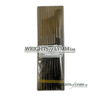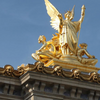Gold Leaf Across the World - Cyprus
- by Sam Wozniak
The Timeless Brilliance of Gold Leaf in Cyprus: A Journey Through Art, Faith, and Restoration
The Mediterranean island of Cyprus has long been known for its sunlit shores, ancient temples, and deep layers of history. But among its many artistic treasures, one craft shines brighter than the rest — gold leaf gilding. The use of goldleaf in Cyprus is a story that stretches across millennia, blending ancient craftsmanship with religious devotion and modern restoration artistry.
From Byzantine icons to monumental architecture, gilding with 24 carat and 23.5 carat gold leaf has played a vital role in expressing faith, luxury, and cultural identity. Today, it remains both a living tradition and a key component of heritage preservation.
Ancient Beginnings: The Early History of Gold Leaf in Cyprus
Cyprus’s relationship with gold dates back to antiquity. Archaeological findings reveal that goldsmithing on the island flourished as early as the Bronze Age, around 2500 BCE. The island’s strategic position between the ancient civilizations of Greece, Egypt, and the Near East made it a cultural crossroads — and gold was a symbol of prestige and divine favour.
The technique of gilding, or applying gold leaf to decorative surfaces, likely arrived in Cyprus through trade with Hellenistic and Egyptian artisans. Goldleaf was used to adorn statues of gods, jewellery, and sacred artifacts, serving both aesthetic and spiritual purposes. The reflective properties of gold were thought to embody the radiance of the divine — an idea that would deeply influence Cypriot religious art for centuries to come.
By the Roman period, gilding had become a refined and prestigious craft. Cypriot workshops produced gilded household items, ceremonial objects, and architectural decorations. Although much of the original gold has long since been lost or repurposed, fragments found in archaeological sites around Paphos and Salamis reveal a sophisticated mastery of thin-sheet metalwork, the precursor to modern gold leaf.
The Byzantine Era: The Golden Age of Religious Gilding
The Byzantine period marked the true flowering of gold leaf art in Cyprus. After becoming part of the Eastern Roman Empire, the island adopted Byzantine artistic styles — particularly the use of gilding in religious iconography and architecture.
Byzantine craftsmen perfected the use of 24 carat gold leaf, prized for its purity and brilliant lustre, to illuminate icons of Christ, the Virgin Mary, and the saints. These gold backgrounds symbolized heaven itself — a spiritual space without shadow or imperfection. In many Cypriot churches, these gilded icons became central to worship, believed to carry divine presence.
Throughout the 11th to 15th centuries, Cypriot iconographers developed their own distinctive style. The use of 23.5 carat gold leaf became common as artisans sought a balance between durability and luminosity. 23.5 carat goldleaf, being slightly less soft than pure gold, allowed for fine tooling and intricate pattern work — especially in the haloes, borders, and backgrounds of icons.
The monasteries of Kykkos, Machairas, and Stavrovouni became renowned centres of icon gilding. Monks and artisans in these sacred spaces produced works that combined faith and artistry in equal measure. Even today, many of these centuries-old icons retain their original gold leaf brilliance, protected by careful restoration efforts and reverent conservation.
Venetian and Ottoman Influences: Evolving Techniques and Aesthetics
As Cyprus passed under Venetian rule (1489–1571), European Renaissance influences began to blend with Byzantine tradition. Venetian artists introduced new gilding techniques, including the use of oil gilding for larger surfaces like altarpieces, ceilings, and frames. This period also saw the spread of architectural gilding, where goldleaf was applied to decorative carvings and mouldings inside monumental churches.
When the Ottomans took control of Cyprus in the late 16th century, Islamic art brought a new wave of inspiration. While Islamic tradition prohibited figural representation, artisans continued to use gold leaf extensively in geometric and calligraphic designs. Mosques and public buildings incorporated gilded motifs in wood, plaster, and metal, reflecting the shared Mediterranean fascination with gold as a symbol of light, life, and sacred beauty.
Gold Leaf in Cypriot Churches: Monumental Faith and Detail
Walk into any historic church in Cyprus — from the Byzantine monasteries in the Troodos Mountains to the cathedrals of Nicosia — and you will encounter the enduring glow of gold leaf. Many of these interiors feature gilded iconostases, or icon screens, separating the sanctuary from the nave. These monumental wooden structures are masterpieces of carving and gilding, covered in layers of 23.5 and 24 carat goldleaf that shimmer under candlelight.
One of the most remarkable examples is the iconostasis of Kykkos Monastery, where gilding covers almost every inch of its elaborate design. Restoration experts have confirmed that both 23.5 carat and 24 carat gold leaf were used — the former for structural endurance, the latter for visual purity. The result is a breath-taking blend of craftsmanship and spirituality.
In such contexts, goldleaf served not only as decoration but as theology. The gleam of gold was seen as the reflection of divine light, transforming the church interior into a vision of the heavenly realm. This monumental gilding tradition remains a hallmark of Cypriot ecclesiastical art.
Restoration and Preservation: Keeping the Gold Alive
Today, Cyprus places great emphasis on the restoration and conservation of its gilded treasures. Many of the country’s gold leaf artworks — especially in icons and altarpieces — have survived for centuries thanks to careful maintenance and expert craftsmanship.
Modern restorers follow traditional gilding methods, using 23.5 carat and 24 carat gold leaf applied over layers of natural gesso and bole clay, just as their predecessors did. These techniques ensure authenticity while preserving the original radiance of the artwork.
Institutions like the Department of Antiquities and the Church of Cyprus collaborate with international conservators to document, clean, and stabilize goldleaf layers on ancient icons and church decorations. Restoration workshops in Nicosia and Larnaca continue to train artisans in these age-old techniques, blending traditional knowledge with scientific analysis to protect the monumental gilded heritage of Cyprus.
Modern Uses of Gold Leaf in Cyprus: From Art to Architecture
While gold leaf remains closely associated with religious art, its use in modern Cypriot design and architecture has expanded dramatically. Contemporary artists, inspired by the island’s gilded past, now incorporate goldleaf into paintings, sculptures, and mixed-media installations. These modern expressions often contrast the eternal beauty of gold with the transient nature of modern life — a reflection of Cyprus’s layered history.
In architecture and interior design, gilding has also made a comeback. Luxury hotels, private villas, and cultural buildings across Cyprus use goldleaf detailing on ceilings, frames, and accent walls to evoke both classical opulence and Mediterranean warmth. Designers often opt for 23.5 carat gold leaf, which maintains a deep yellow tone without tarnishing, making it ideal for decorative finishes that withstand the island’s coastal climate.
Even in smaller crafts, such as jewellery, ceramics, and custom iconography, Cypriot artisans continue to celebrate the art of gold leaf. Many workshops now combine traditional Byzantine gilding methods with modern aesthetics, producing works that appeal to both local collectors and international audiences.
The Symbolism and Legacy of Gold Leaf in Cypriot Culture
Goldleaf in Cyprus is far more than an artistic material — it is a cultural symbol. Throughout history, the radiance of gold has represented eternity, divinity, and human aspiration toward the divine. In a land shaped by ancient myth and enduring faith, this symbolism runs deep.
The island’s monumental gilded artworks are not only visual masterpieces but also testaments to the spiritual resilience of the Cypriot people. Each layer of gold leaf tells a story — of empire and empire’s fall, of faith kept through hardship, and of beauty preserved against time.
Today, through ongoing restoration efforts and creative revival, the legacy of goldleaf in Cyprus continues to shine — bridging the ancient and the modern, the sacred and the artistic.
Conclusion: A Golden Thread Through Cypriot History
From Bronze Age craftsmanship to Byzantine iconography and contemporary design, gold leaf in Cyprus has maintained its status as a symbol of brilliance and continuity. The meticulous use of 23.5 carat and 24 carat goldleaf in both monumental art and restoration underscores its timeless significance.
Cyprus’s gilded heritage stands as a radiant reminder that true artistry — much like gold itself — never fades. As long as there are hands to apply it and eyes to admire it, the golden tradition of Cypriot gilding will continue to gleam across centuries, illuminating both faith and culture in equal measure.






